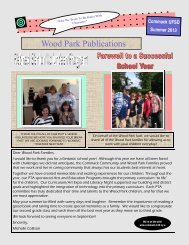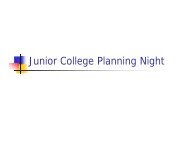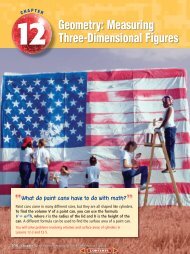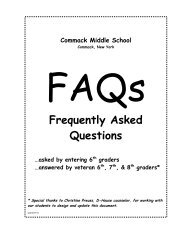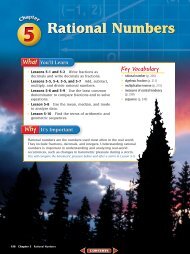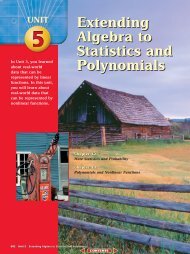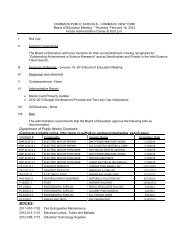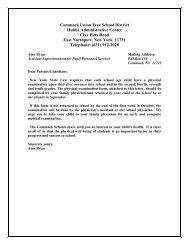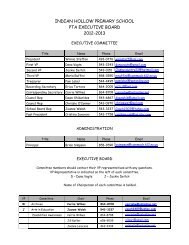Eighth Grade - Commack Union Free School District
Eighth Grade - Commack Union Free School District
Eighth Grade - Commack Union Free School District
Create successful ePaper yourself
Turn your PDF publications into a flip-book with our unique Google optimized e-Paper software.
WELCOME TOCOMMACKMIDDLE SCHOOLA United States Blue Ribbon <strong>School</strong> ofExcellence
WELCOME TO GRADE EIGHTIT’S ALL ABOUT TEAM!Recognizing the importance of interdisciplinary learning and the coordination ofinstruction in our Middle <strong>School</strong> and for all students to have a sense of identityand belonging – especially in a large building such as ours, all students areteamed. In grade 8 teaming includes the subjects of English, Social Studies,Math, and, where possible, Science.What is teaming?Teaming is a way of organizing teachers and students into small communitiesfor teaching and learning. The eighth grade teams generally are comprised offour or more teachers who teach the “academic” subjects on the team. Teamedteachers share common planning periods to prepare for teaching a commongroup of students.What would a typical eighth grader’s schedule look like?Our school has an alternate-day schedule of 9 periods, each 40 minutes long.Students have 4 minutes to pass from class to class between periods. All schooldays are designated either a “gold day” or a “white day” and they alternatecontinuously. Every day, students will be reminded with signs andannouncements of which day’s schedule to follow.Classes which are scheduled for alternating days are Music and the ElectiveCourses. Students may take Physical Education as an alternate-day course or asa daily course. <strong>Eighth</strong> grade students also have a “wheel period.” They attend awheel class daily, but change wheel classes (Art, Health, Family & ConsumerScience, and Technology) every quarter.Finally, all students have a separate 8-minute homeroom period at thebeginning of the day for taking attendance and making announcements.Students are grouped in homerooms by guidance counselor to facilitate thecounselors’ communicating with their counselees throughout the year.
A Typical Schedule for an 8 th <strong>Grade</strong>rPerDaysQtrGold Day Class1 daily all Homeroom (8 minutes) same2 daily all English same3 daily all World Languages (French, sameGerman, Italian or Spanish4 daily all Earth Science sameWhite Day Class5 alt days all Earth Science Lab Elective Course* orAIS**6 daily all Math same7 daily all Lunch same8 alt days all Physical Education Music or ElectiveCourse* or AIS**9 daily 1 Wheel: Art same2 Technology same3 Family & ConsumerSciencesame4 Health same10 daily all Social Studies same
AIS8 Wilson Reading Program (daily instruction for students deficient in basicskills)8 Reading Comprehension Program (daily instruction for skill-deficientstudents.ACADEMIC INTERVENTION SERVICESThe AIS CurriculumReading and Math AIS provide instruction in developing and improving skillsin reading comprehension, phonics, and decoding, writing, listening, problemsolving, and computation in response to each student’s individual needs.Students learn to apply these skills and strategies to their work in academicclasses. Instruction is provided by a reading specialist, English teacher or mathteacher.Criteria For Placement in AIS classesAll students receiving a score of “1” or “2” on the New York StateAssessment in grade 4 and who did not exit out of the program in theintermediate school are scheduled into an AIS class.For all other students, multiple criteria are used for placement and include aconsideration of:8 scores below the 35 th percentile on the TerraNova exam and supplementaryreading and math test.8 a review by the building Student Evaluation Committee8 classroom performance in reading or English and math8 the teachers’ and guidance counselors’ recommendations.Types of Services
ELECTIVE COURSES<strong>Eighth</strong> grade students have several choices for customizing their programsdepending on their interests and academic needs. The number of choicesdepends on whether or not the student is enrolled in the modified Earth ScienceProgram, taking the Regents Exam in June of 8 th grade, and whether or not thestudent needs tutorial assistance and may be assigned to a Learning Lab inspecific subject areas.The choices include taking alternate-day Music (band, orchestra, or chorus),Physical Education daily, and one or more alternate-day Elective Courses mostof which carry one-half high school elective credit.The range of choices of Elective Courses changes yearly, depending onstudent interest, availability of specialized facilities, and availability of certifiedstaff. All the electives are designed to be exploratory, interesting, andenjoyable; and so will include minimal-if-any homework or outside–of-classstudy. Students in the elective courses will have the opportunity at the end ofthe 1 st quarter to declare if they want to earn a numerical grade in the course ortake the course as pass/fail. Pass/Fail grades will not be included in thestudent’s average and will not jeopardize the student’s eligibility for honor rollor membership in the National Junior Honor society. Numerical grades will beincluded in the student’s average for honor roll status and eligibility for theHonor Society. Any course taken for pass/fail credit may not be used as partof a graduation sequence or to fulfill a “core” requirement needed for highschool graduation.The Elective Course choices typically include:‣ Close Encounters: UFOs and Other Phenomena which leads studentsthrough an investigation of reported extra-terrestrial visitations andrelated phenomena.‣ Computer Graphics A which explores the world of computer graphics topursue individual ideas and create artwork on the computer for fun andpractical applications.‣ Clothing design: from Style to Stitches which allows students to explorethe world of fashion and to design and construct their own creations.‣ Computer Programming I which introduces students to the fundamentalsof computers and computer programming.
ELECTIVE COURSES, con’t.‣ Guitar Class which gives students the opportunity to learnto play the instrument, to write and perform originalcompositions, and to recognize excellence in performance and theworks of famous players.‣ Introduction to Computer Graphics which allows students to pursuetheir own ideas in designing and developing art on the computer.‣ Justice and the US Judicial System which acquaints students with thebasic operation of the American judicial system and allows them toformulate arguments regarding important legal principles.‣ Kaleidoscope which offers students an introductory survey of worldcultures, comparing customs and traditions and contributions to our globalsociety.‣ Lifetime Adventures which gives the enthusiastic physical educationstudent the opportunity to improve agility, coordination, and fitness in asmall-group setting.‣ Math-Science-Technology Education which engages students in activelydesigning and solving real problems in our technological society.‣ Soup to Nuts which gives students further experience in menu planning,food preparation, and healthy eating.‣ Sports and American Society examines trends in professional, amateurand youth sports from colonial times to the present in the context of issuesin American history such as racism, economics, civil rights, discrimination,and immigration.‣ Studio in Art A which provides students with the requisite foundation inart expression and techniques – through drawing, painting, printmaking,and construction, for further study in art.‣ Young Financial Marvels presents an interdisciplinary approach toeconomics. Students will demonstrate an understanding of how theUnited States and other countries develop economic systems.
ENGLISHIn keeping with the NYS Learning Standards for English Language Arts,eighth grade students will read, write, listen, and speak for information andunderstanding through:8 participating in discussions or debates in which they attempt to resolve aproblem or issue.8 reading aloud original composition drafts and/or journals to share ideas,build confidence, and clarify personal concepts.8 reading aloud original poems, essays, and stories to share and explore theimmediate impressions and/or reaction.8 presenting and explaining project work.8 listening to oral readings and/or commercial recordings andand responding orally or in writing.8 developing vocabulary skills by studying:• word breakdown.• word families.• word context.• synonyms and antonyms.• connotation and denotation.• clarification and comprehension.• word relationships in analogies.Students will read, write, listen, and speak for literary response and expressionthrough:8 reading poetry, plays, novels, essays, and short stories.8 studying the story elements and literary devices used by authors to conveysubtle meanings.8 reading to define and clarify values.8 reading for pleasure.Students will read, write, listen, and speak for critical analysis and evaluationthrough:8 composition and writing:• using the word processor.• using the Internet for research.
ENGLISH CON’T.Students will read, write, listen, and speak for social interaction through:8 practicing the following writing modes.• letters.• poems.• personal and persuasive essays.• first- and third-person narratives.• book and movie reviews.• short stories.• dialogues.• journals.• pieces for contests and student publications.• email messages.
2. A Safe and Healthy Environment. Students will acquire the knowledgeHEALTHHealth is a ten-week course offered as part of our Art,Technology, and Family & Consumer Science wheel. Ineighth grade Health, students will learn to:8 identify proper health practices and appropriate choices for well-being.8 understand nutritional requirements and select foods to meet requirements.8 appreciate self-worth and practice tolerance for individual differences.8 identify uses and abuses of alcohol, tobacco, and other drug substances;and learn how to avoid misuse of these products.8 become aware of the relationships between one’s environment, dailyliving, and the quality of life.8 recognize diseases and disorders and the strategies employed to avoidhealth-related problems.8 understand the safety hazards present in daily living and how to respond inemergency situations.Additionally, eighth grade Health students will learn about:8 human growth and development, family living, human sexuality,sexuality transmitted diseases with an emphasis on AIDS instruction.8 mental and emotional health, stress, illnesses and treatments.8 nutrition, eating disorders, and meal planning.8 fitness and exercise with emphasis on a personal fitness plan.8 tobacco, alcohol, drug and substance abuse and addiction.Our expectations for student achievement are clear in theNYS Learning Standards for Health, Physical Education, andHome Economics:1. Personal Health and Fitness. Students will have the necessaryknowledge and skills to establish and maintain physical fitness,participate in physical activity, and maintain personal health.
LIBRARYIn eighth grade, students will:8 continue to review library skills previously mastered.8 use appropriate research materials to investigate in depth at least twocareers.8 locate information from a variety of sources on a country wherethe foreign language he/she is studying is spoken.8 use bibliographical reference sources to locate pertinent information.8 prepare annotated bibliographies reflecting higher-level research strategiesand techniques.8 evaluate and select literature as an aid to understanding and appreciationof interdisciplinary connections; e.g., historical fiction, biography.8 use periodicals for contemporary opinions and current editorial commentson a given subject, person, or event.8 utilize computer resources, CD-ROM programs, and online sources asresearch tools.
MATHEMATICSAll students in eighth grade will begin the new Course A curriculum, a1 ½-year program leading to the Course A Regents Exam. Honors andaccelerated math students will take the new Course A Regents Exam in Januaryof their 9 th grade year. Selected students may take the Course A Regents Examin June of 8 th grade. All other students will take the Course A Regents Exam inJune of their 9 th grade year.Students learn mathematics best through an interdisciplinary approach thatconnect Mathematics with Science and Technology in accordance with the NYSLearning Standards for Mathematics, Science, and Technology:1. Analysis, Inquiry, and Design. Students will use mathematicalanalysis, scientific inquiry, and engineering design, as appropriate, topose questions, seek answers, and develop solutions.2. Information Systems. Students will access, generate, process, andtransfer information using appropriate technologies.3. Mathematics. Students will understand mathematics and becomemathematically confident by communicating and reasoningmathematically, by applying mathematics in real-world settings, andby solving problems through the integrated study of n umber systems,geometry, algebra, data analysis, probability, and trigonometry.6. Interconnectedness: Common Themes. Students will understand therelationships and common themes that connect mathematics, scienceand technology and apply the themes to these and other areas oflearning.7. Interdisciplinary Problem Solving. Students will apply the knowledgeand thinking skills of mathematics, science, and technology to addressreal-life problems and make informed decisions.In Math Course A, students are encouraged to:8 use calculators and computers whenever appropriate.8 develop thinking strategies that make sense out of math and lead topowerful logical reasoning.8 make connections between math topics and other subject areas sostudents can use and remember math skills long after the chapter test
MUSICIn eighth grade Music, students will have the opportunity toparticipate in the alternate-day courses of Orchestra, Band,Chorus, or an elective course in Music.Additionally, the instrumentalist who also enjoys singing will have theopportunity to join a Lunch Chorus which will meet on alternate days duringhis/her lunch period. Students in Lunch Chorus go first to the music class for20 minutes, then are escorted by the music teacher to the cafeteria where theywill eat their lunch in the remaining 20 minutes.In their music classes in the eighth grade, students in the Middle <strong>School</strong> willmeet the expectations set forth in the NYS Learning Standards for The Arts:1. Creating, Performing, and Participating in the Arts. Students willactively engage in the processes that constitute creation andperformance in the arts (dance, music, theater, and visual arts) andparticipate in various roles in the arts.2. Knowing and Using Arts Materials and Resources. Students will beknowledgeable abut and make use of the materials and resourcesavailable for participation in the arts in various roles.3. Responding to and Analyzing Works of Art. Students will respondcritically to a variety of works in the arts, connecting the individualwork to other works and to other aspects of human endeavor andthought.4. Understanding the Cultural Contributions of the Arts. Students willdevelop an understanding of the personal and cultural forces that shapeartistic communication and how the arts in turn shape the diversecultures of past and present society.In Orchestra, Band, and Chorus, students will develop:
PHYSICAL EDUCATIONPhysical Education is a full-year course which meets onalternate days, opposite Music. It works to integrate the NYSLearning Standards for Health, Physical Education, and HomeEconomics by focusing on student expectations in:1. Personal Health and Fitness. Students will have the necessaryknowledge and skills to establish and maintain physical fitness,participate in physical activity, and maintain personal health.2. A Safe and Healthy Environment. Students will acquire theknowledge and ability necessary to create and maintain a safe andhealthy environment.In eighth grade Physical Education, students will learn to:8 practice responsible behavior through sportsmanship.8 develop individual accountability through maintaining a physical educationlocker, keeping the combination private, and securing personal belongings.8 contribute to a healthy lifestyle by providing a change of clothes foroptimum and safe physical performance.8 develop socialization and cooperative-effort skills through game playin individual and team activities.8 explore personal movement abilities through an emphasized participationin stunts and tumbling.
SCIENCEScience is a body of knowledge which students learn best through aninterdisciplinary approach connecting Science with mathematics andTechnology. In accordance with the New York State Learning Standards,Science at CMS is taught through analysis and inquiry, whereby students areshown how to integrate current technology with scientific and mathematicalprinciples and concepts. Additionally, through application of the scientificmethod, students are taught to use critical thinking strategies for developingquestions and solutions.To that end, in eighth grade, students will take Regents Earth Science.Students who have demonstrated skill deficiencies that would preclude theirsuccess in Regents Earth Science at this time take non-Regents Earth Science in8 th grade and Fundamentals of Biology in 9 th grade. All other 8 th graders takeeither the Modified Regents Earth Science course which includes an alternatedaylab period and which culminates in the Regents Exam in June, or theExtended Earth Science course which includes lab time in both the single periodof 8 th grade and the additional alternate-day period in 9 th grade and whichculminates in the Regents Exam in January of 9 th grade.All 8 th graders will learn through first-hand experience abut he world aroundthem and the processes of change and dynamic equilibrium. To be eligible totake the Regents Exam in Earth Science, students must have completed not lessthan 30 laboratory experiences in areas such as:8 the local environment• Measurements.• Properties.• Graphing.8 the nature of change• Characteristics of change.• Energy and change.• Equilibrium.8 earth measurements• Models.• Earth structure.
SCIENCE Con’t.8 meteorology and atmospheric energy• Energy transfer.• Atmospheric relationships• Weather maps and forecasting.• Storm systems.8 the water cycle and climates• Weather and climate• Water cycle and water budget.• Insulation.• Radiation.8 surface processes• Weathering and erosion.• Deposition.• Life history of a stream.8 minerals and rocks• Mineral and rock relationships.• Rock cycle.8 the dynamic crust• Plate tectonics.• Diastrophism.• Earthquakes.• Crust changes.8 earth’s history and landscapes• Geologic history.• Rock correlation.
SOCIAL STUDIESWhile building on and reinforcing previous learning, the eighth grade SocialStudies program concentrates on the United States and New York State history.In keeping with the NYS Learning Standards for Social Studies:1. History of the United States and New York. Students will use a varietyof intellectual skills to demonstrate their understanding of major ideas,eras, themes, developments, and turning points in the history of theUnited States and New York.2. World History. Students will use a variety of intellectual skills todemonstrate their understanding of major ideas, eras, themes,developments, and turning points in world history to examine the broadsweep of history from a variety of perspectives.3. Geography. Students will use a variety of intellectual skills todemonstrate their understanding of the geography of the interdependentworld in which we live – local, national, and global – including thedistribution of people, places, and environments over the Earth’ssurface.4. Economics. Students will use a variety of intellectual skills todemonstrate their understanding of how the United States and othersocieties develop economic systems and associated institutions toallocate scarce resources, how major decision-making units function inthe Untied States and other national economies, and how an economysolves the scarcity problem through market and non-marketmechanisms.5. Civics, Citizenship, and Government. Students will use a variety ofintellectual skills to demonstrate their understanding of the necessityfor establishing governments; the governmental system of the UnitedStates and other nations; the United States Constitution; the basicvalues of American constitutional democracy; and the roles, rights, andresponsibilities of citizenship, including avenues of participation.
Social Studies con’t.8 The United States between the World Wars8 The United States Assumes World Responsibilities8 The Changing Nature of the American People from World War II to thePresent8 Citizenship in Today’s WorldUpon completion of eighth grade Social Studies, student will be able todemonstrate their knowledge of:8 the broad chronological survey of United States and New York Statehistory with linkages to our neighbors, Canada and Mexico, whereappropriate.8 the causes and results of the major events that have shaped the nation andand New York today, with pertinent references to the Western Hemisphere.8 the diverse racial and ethnic groups that make up American society andtheir contributions to American life.8 the structure and function of the family at particular points in our history.Upon completion of eighth grade Social Studies, student will be able to:8 prepare themselves for active citizenship in a democratic society.8 keep an open mind when studying divergent points of view.8 recognize and understand differences among people (racial, religious,ethnic, cultural, regional) without prejudice or bigotry.
SPECIAL SERVICESStudents who have been designated by the <strong>District</strong> Committee on SpecialEducation will be provided with support services in inclusion classes, in aresource-room setting, or in self-contained classes.In inclusion classes, classified students and regular-education students attendthe same class taught jointly by the subject-area specialist and the specialeducation teacher. Most inclusion classes additionally have the support of ateaching assistant.In the resource room, students whose educational programs include allmainstreamed classes will be provided with academic support in all subjectareas, including regents and accelerated classes, from a special education teacherfor one period per day. In the resource room, students will develop:8 compensatory learning strategies which enable the State EducationDepartment Learning Standards of all academic content areas to be met.8 organizational skills8 study skills.In self-contained classes, students with Individualized Education Plans will beprovided with developmentally appropriate instruction which parallels theacademic subject areas outlined within the curriculum guide. The IEP will beutilized to determine eligibility for each subject specific class. Mainstreamingwill occur wherever appropriate.
TECHNOLOGYTechnology is a ten-week course offered as part of our Art, Health, and Family& Consumer Science wheel. It works to integrate the NYS Learning Standardsfor Mathematics, Science, and Technology by focusing on student expectationsin:1. Analysis, Inquiry, and Design. Students will use mathematicalanalysis, scientific inquiry, and engineering design, as appropriate, topose questions, seek answers, and develop solutions.2. Information Systems. Students will access, generate, process, andtransfer information using appropriate technologies.3. Technology. Students will apply technological knowledge and skills todesign, construct, use, and evaluate products and systems to satisfyhuman and environmental needs.4. Interconnectedness: Common Themes. Students will understand therelationships and common themes that connect mathematics, science,and technology and apply the themes to these and other areas oflearning.5. Interdisciplinary Problem Solving. Students will apply the knowledgeand thinking skills of mathematics, science, and technology to addressreal-life problems and make informed decisions.In eighth grade Technology, students will learn to:8 explore and experience how people solve technological problems byusing a problem-solving system.8 use computers to design and enhance practical solutions to problems.8 use advanced tools and machines.8 work in groups to solve and present solutions to problems.
WORLD LANGUAGESThe eighth grade World Languages program offers courses in French, German,Italian, and Spanish. The initial thrust of the program is on listening andspeaking skills, understanding and making oneself understood, in compliancewith the NYS Learning Standards for World Languages:1. Communication Skills. Students will be able to use a language other thanEnglish for communication.2. Cultural Understanding. Students will develop cross-cultural skills andunderstandings.In the eighth grade proficiency-level classes (in Spanish only), students areexpected to achieve communicative competence in:8 greetings and farewells.8 numbers, telling time, reciting dates.8 expressions of courtesy.8 the weather.8 family and personal information.8 school.8 origin and nationalityIn the eighth grade regents-level and accelerated World Languages classes,students are expected to achieve communicative competence in:8 social comments.8 giving directions.8 money and banking.8 the weather.8 family and personal information.8 school and business.8 travel expressions.
DISCIPLINEEvery pupil is expected to observe all regulations of the school and obey thedirections of the adults in charge. Pupils are asked to conduct themselves at alltimes and in all school places in such a way that will insure the safety ofthemselves, others, and their own and others’ property.The district has a complete disciplinary code for students and studentbehavior, which is mailed home to parents in August yearly. This code isincluded in Board Policies and Regulations 5114, 5114.1, 5114.2, and 5114.3,copies of which are available to parents and students at any time.At the Middle <strong>School</strong>, every effort is made to resolve disciplinary problemsarising in class with the classroom teacher. Should that resolution not occur orshould the disciplinary problem arise outside of a class, then parents should bein touch with the dean, guidance counselor, or building administrator (in thatorder). When necessary, the district allows for a program of progressivedisciplinary actions, ranging from verbal and written admonitions to suspensionfrom school. All disciplinary actions are preceded by a hearing of the studentcharged as well as other students who may have been involved or witnessed theproblem, with the teacher, dean, counselor or administrator.
HOMEWORKAt the Middle <strong>School</strong>, parents continue to play an important role in assistingwith homework. Students at this level will usually have between 60 and 120minutes of homework each night, and additional time on weekends andholidays.Homework assignments can be a review and reinforcement of material alreadylearned, an extension or enhancement of already-learned material where studentshave to apply information in a new way, or preparation for an upcoming lessonor assignment.Parents’ role with homework is quite important. The parent provides anextension of the classroom teacher’s relationship with the child. To this end,parents are encouraged to communicate with the teacher (by note, telephone,e-mail, or the Student Planner) if their child has difficulty with an assignment orrequires an excessive amount of time to complete the task.Middle school students still need to be helped with organizing theirassignments, budgeting their time, and finding a quiet area away fromdistractions. We need to remember that, at this level, students sometimes forgetthat they have been given long-term assignments for which they need to allocatesome of their homework time. The parents’ reminding them of thoseassignments can be helpful.Parents need to remember that their role is that of “helper” and “monitor”when it comes to their child’s assignments. They should not have to do thehomework for their child. One way of helping might be, at times, to providedrill and practice on those tasks which are best learned through repetition.The Student Planner is a helpful instrument for monitoring homeworkassignments. All students are required to record their assignments from eachclass in their Planners (also called “Agendas”). There is space on each day’spage for the parent and the teacher to write comments and effectivelycommunicate with each other. Parents should take advantage of their child’sPlanner and review it daily.In the first week of school, students are required to list two “HomeworkBuddies” for each class in their Planners. If a child is absent for one, two, orthree days, she/he should call her/his Homework Buddies to get the assignments.



